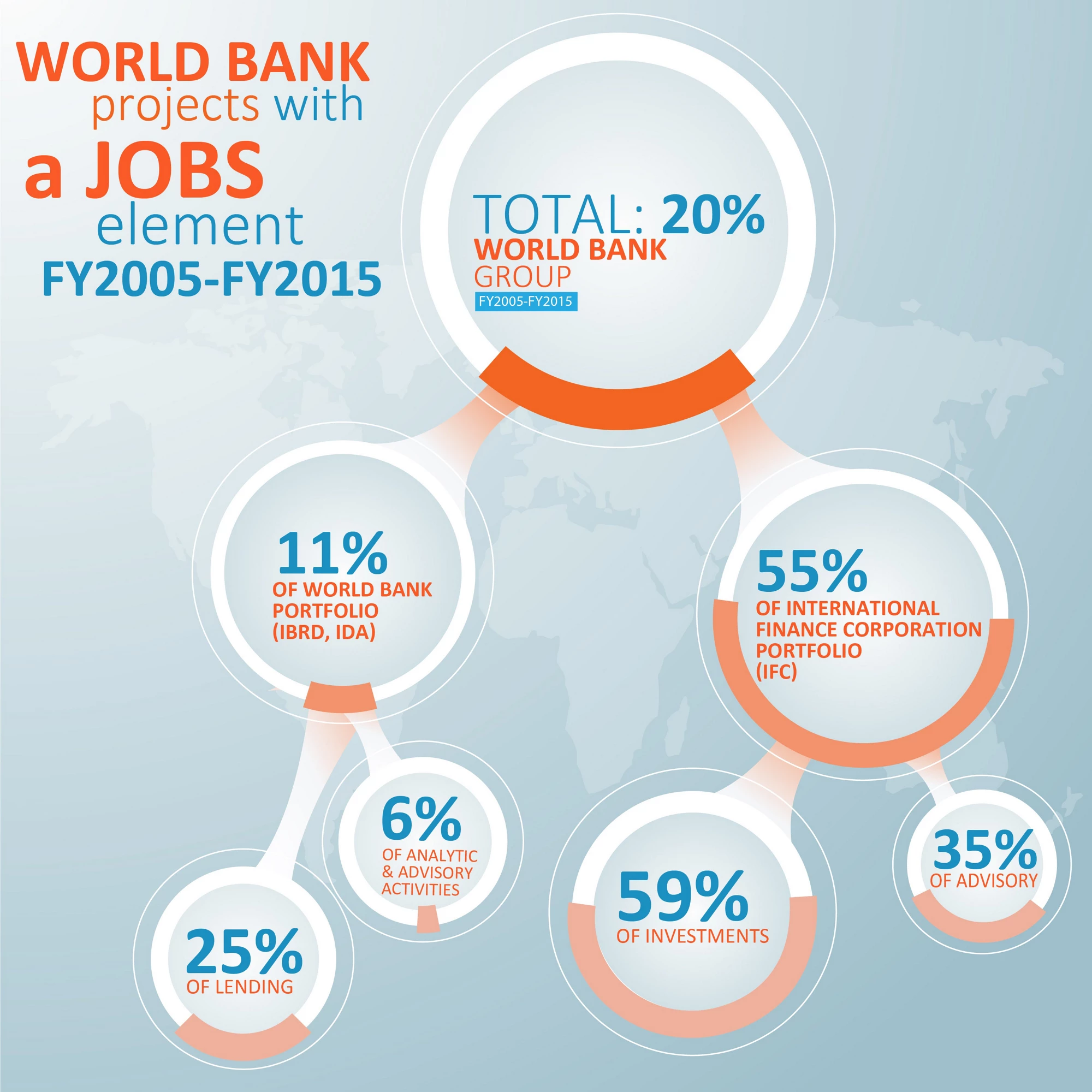Measuring how our work at the World Bank Group (WBG) impacts jobs is a clear operational challenge. But we are supporting teams and clients in meeting this challenge in a number of ways. Exploring how growth leads to more, better, and inclusive jobs, and developing tools to capture these impacts, has been the focus of results measurement work on jobs.
Specifically, we are looking at how best we can mainstream jobs in our activities as a pathway to meeting our twin goals. We are also improving how we articulate job outcomes in individual projects through job diagnostics and national strategies. Through clearer theories of change, we are achieving better measurement of job results.
Large demand for jobs data
A recent meeting with interested project teams emphasized to us how simple measures that can be easily implemented with clients are needed across a diverse array of operations. This need is consistently voiced by donors and clients alike, given the increasing demands to demonstrate job impacts. Indeed we have found that 20% of the total World Bank Group portfolio has a jobs angle, based on an explicit and substantive focus (see below). This is more than 7,000 separate projects – both investments and analytical work – over the past ten years.

Not only do we want to create more jobs, but we also need to create better jobs and more inclusive jobs. For instance, at the recent Tourism Forum, many high level speakers emphasized the opportunity for creating jobs and value chains in this sector all around the world. IFC has undertaken development impact case studies on the positive indirect and induced numbers of job effects of hotel investments in Ghana, Mali, and the Maldives. They have also found that the economic impacts of skills upgrading among local workers and product standards benefited local SME suppliers. While creating new jobs is vital, we also have to improve the stock of existing jobs. Our colleagues in the Social Protection and Labor Practice have been extremely active in programs that provide relevant training and skills in line with private sector needs.
Some of these operations are specifically focused on jobs and direct job creation. These could be those that work directly with private sector firms to expand employment, increase employability, improve earnings or livelihoods, and strengthen entrepreneurship. These direct results can be evaluated and measured. But we know that other job- or income-generating opportunities may be catalyzed as an indirect result of these operations. So if we are going to target job creation and improvement as key ways of reducing poverty and increasing shared prosperity, we have to be able to scale up our reach – and focus efforts on measuring significant, indirect impacts.
Other operations may affect jobs in a positive way, but less explicitly. For example: operations that target key legislative reform in trade, investment climate, or labor regulations; or those operations that provide access to financial services, promote private sector growth, or improve labor market functioning. In our review of the WBG portfolio, it became clear that there is not one specific outcome or indicator that can capture the range of approaches and results in the jobs agenda. We will need to look at both intermediate outcomes and medium- to long-term jobs outcomes, along the results chain, with a menu of measurement approaches for teams and clients.
Improving Measurement Indicators
We are meeting this shared wish for better measurement by developing guidance, support and tools. In particular, we have developed a limited set of standard indicators for key jobs outcomes. For instance, when looking at measuring more jobs, we can assess the number of full-time employees, the number of new jobs created by new firms or the percentage increase in the number of self-employed. We can also look at how jobs are improving by measuring the value-added per worker, increases in earnings, or the number of people who move from part-time to full-time positions.
We can then look one stage further and see how the jobs environment has improved. We can measure the number of people with access to infrastructure, the growth in labor force participation of beneficiaries, improvements in human capital via training, and how long it takes firms to hire and people to find jobs.
While working to improve our range of relevant jobs outcome indicators, we will also look at the number of beneficiaries reached by the various jobs-focused operations across the portfolio, and share this with our stakeholders through the WBG Corporate Scorecard.
Collaboration to Standardize Measurement Tools
A major stumbling block to measuring jobs in the past has been finding a standard approach to these measurements, especially among clients and other development finance institutions. Our Jobs Group colleagues have been working through the Let’s Work Partnership in taking the lead in developing, refining and applying standardized methodologies among 30 development partners for measuring the indirect, induced and secondary jobs impacts of projects with private sector clients. They are developing these tools as a public good which can drive the global jobs agenda. The next step will be to make sure that metrics and methodologies can be easily embedded into operations in a simple and consistent way. For project teams and clients to use such tools, they must be pragmatic, user-friendly and cost-effective, and based on tests and feedback.
Rigorously measuring and evaluating the jobs effects may also shape how future projects are designed and implemented. Let’s take an example of The Gambia Gateway project to create a free trade zone and industrial park in one of the smallest countries in Africa. Results were tracked through the companies supported by the project. Specifically, a target of 4,000 jobs was included in the project’s design. In the end, 4,605 new direct jobs were created as a result of the project. Looking at such projects through a jobs lens demands that we measure the jobs impacts of the work we do, which has not been systematically done in the past. Challenges of categorization, attribution and accuracy remain. We need to look hard at whether jobs are actually being created or are people simply moving from one job to another. But with our new conceptual framework, operational guidance, and measurement tools, we are overcoming these challenges to deliver and capture job impacts. Stay tuned – more information on these tools will be available in the coming months.
Specifically, we are looking at how best we can mainstream jobs in our activities as a pathway to meeting our twin goals. We are also improving how we articulate job outcomes in individual projects through job diagnostics and national strategies. Through clearer theories of change, we are achieving better measurement of job results.
Large demand for jobs data
A recent meeting with interested project teams emphasized to us how simple measures that can be easily implemented with clients are needed across a diverse array of operations. This need is consistently voiced by donors and clients alike, given the increasing demands to demonstrate job impacts. Indeed we have found that 20% of the total World Bank Group portfolio has a jobs angle, based on an explicit and substantive focus (see below). This is more than 7,000 separate projects – both investments and analytical work – over the past ten years.

Not only do we want to create more jobs, but we also need to create better jobs and more inclusive jobs. For instance, at the recent Tourism Forum, many high level speakers emphasized the opportunity for creating jobs and value chains in this sector all around the world. IFC has undertaken development impact case studies on the positive indirect and induced numbers of job effects of hotel investments in Ghana, Mali, and the Maldives. They have also found that the economic impacts of skills upgrading among local workers and product standards benefited local SME suppliers. While creating new jobs is vital, we also have to improve the stock of existing jobs. Our colleagues in the Social Protection and Labor Practice have been extremely active in programs that provide relevant training and skills in line with private sector needs.
Some of these operations are specifically focused on jobs and direct job creation. These could be those that work directly with private sector firms to expand employment, increase employability, improve earnings or livelihoods, and strengthen entrepreneurship. These direct results can be evaluated and measured. But we know that other job- or income-generating opportunities may be catalyzed as an indirect result of these operations. So if we are going to target job creation and improvement as key ways of reducing poverty and increasing shared prosperity, we have to be able to scale up our reach – and focus efforts on measuring significant, indirect impacts.
Other operations may affect jobs in a positive way, but less explicitly. For example: operations that target key legislative reform in trade, investment climate, or labor regulations; or those operations that provide access to financial services, promote private sector growth, or improve labor market functioning. In our review of the WBG portfolio, it became clear that there is not one specific outcome or indicator that can capture the range of approaches and results in the jobs agenda. We will need to look at both intermediate outcomes and medium- to long-term jobs outcomes, along the results chain, with a menu of measurement approaches for teams and clients.
Improving Measurement Indicators
We are meeting this shared wish for better measurement by developing guidance, support and tools. In particular, we have developed a limited set of standard indicators for key jobs outcomes. For instance, when looking at measuring more jobs, we can assess the number of full-time employees, the number of new jobs created by new firms or the percentage increase in the number of self-employed. We can also look at how jobs are improving by measuring the value-added per worker, increases in earnings, or the number of people who move from part-time to full-time positions.
We can then look one stage further and see how the jobs environment has improved. We can measure the number of people with access to infrastructure, the growth in labor force participation of beneficiaries, improvements in human capital via training, and how long it takes firms to hire and people to find jobs.
While working to improve our range of relevant jobs outcome indicators, we will also look at the number of beneficiaries reached by the various jobs-focused operations across the portfolio, and share this with our stakeholders through the WBG Corporate Scorecard.
Collaboration to Standardize Measurement Tools
A major stumbling block to measuring jobs in the past has been finding a standard approach to these measurements, especially among clients and other development finance institutions. Our Jobs Group colleagues have been working through the Let’s Work Partnership in taking the lead in developing, refining and applying standardized methodologies among 30 development partners for measuring the indirect, induced and secondary jobs impacts of projects with private sector clients. They are developing these tools as a public good which can drive the global jobs agenda. The next step will be to make sure that metrics and methodologies can be easily embedded into operations in a simple and consistent way. For project teams and clients to use such tools, they must be pragmatic, user-friendly and cost-effective, and based on tests and feedback.
Rigorously measuring and evaluating the jobs effects may also shape how future projects are designed and implemented. Let’s take an example of The Gambia Gateway project to create a free trade zone and industrial park in one of the smallest countries in Africa. Results were tracked through the companies supported by the project. Specifically, a target of 4,000 jobs was included in the project’s design. In the end, 4,605 new direct jobs were created as a result of the project. Looking at such projects through a jobs lens demands that we measure the jobs impacts of the work we do, which has not been systematically done in the past. Challenges of categorization, attribution and accuracy remain. We need to look hard at whether jobs are actually being created or are people simply moving from one job to another. But with our new conceptual framework, operational guidance, and measurement tools, we are overcoming these challenges to deliver and capture job impacts. Stay tuned – more information on these tools will be available in the coming months.



Join the Conversation